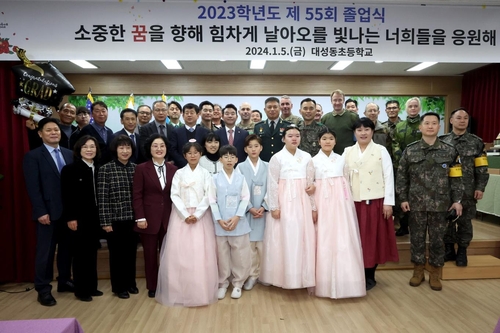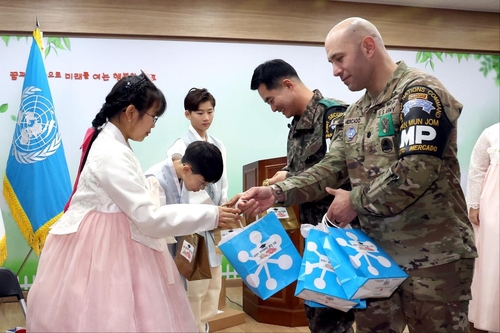
PAJU: Tensions have escalated amid tit-for-tat military moves between the two Koreas along the border, but life goes on as usual for the students of Daeseongdong Elementary School, the only school inside the Demilitarized Zone (DMZ).
Five sixth-graders wearing the Korean traditional clothing, hanbok, enjoyed their unforgettable moment with parents and teachers during a graduation ceremony, which was guarded by armed soldiers from the United Nations Command (UNC) security battalion.
Dozens of senior South Korean and U.S. military officials, as well as senior members of the Neutral Nations Supervisory Commission, which oversees the 1950-53 Korean War armistice, attended the celebrated annual event in the Daeseongdong Freedom Village.
The village is the only inhabited area in the 4-kilometer-wide buffer zone separating the two Koreas, located just south of Kijong-dong, its North Korean counterpart. South and North Korea decided to build their model villages in 1955 to extol their respective superiority after the war.
At the school inside of the world’s last-remaining Cold War frontier, congratulatory messages were somewhat different from what ordinary elementary school students hear from their graduation ceremonies.
Maj. Gen. Choi Chang-soo, the commander of the 1st Infantry Division, said the school under the jurisdiction of the U.S.-led UNC is a symbol of the bilateral alliance between Seoul and Washington.
“I want the young students to grow up as adults who contribute to security and global peace,” Choi said during the ceremony, attended by a group of journalists.
One out of the five graduating students is a Daeseong native, while the rest of them were bused in daily from Munsan, the nearest town outside the DMZ.
The school now has 30 students and 22 teachers and other staff. A total of 226 students have graduated from there since it was established in 1968.
Yoon Young-hee, the school’s principal, called out each of the five students’ names and introduced their future dreams to special guests.
“I want you to savor memories from the school as it will be hard for you to come back here after graduation,” said Yoon, who retires next month after 40 years in the job.
Access to the village is strictly limited to about 180 residents, who have to pass through several checkpoints when entering and leaving the area.
Villagers, all of them original inhabitants and their direct descendants, must abide by a midnight curfew and spend more than eight months a year there to maintain their residential cards. They are guarded by Joint Security Area personnel while farming.
In return for the inconveniences, residents pay no taxes and men are exempted from the mandatory military service.
The ceremony, filled with laughter, claps and hopeful messages for the next stage in life, felt a little surreal as it was held against the backdrop of the escalating military tension along the shared border.

On Friday, North Korea fired around 200 rounds of artillery shells into waters off its western coast, prompting residents on two South Korean western border islands to take shelter. In response, the South Korean military staged live-fire drills on the northwestern islands.
It was the latest saber-rattling by the North after it vowed to restore all military measures halted under the 2018 inter-Korean military tension reduction agreement in late November.
The agreement signed under former liberal President Moon Jae-in set up buffer zones on land, sea and air and banned live-fire drills near the border to prevent accidental clashes between the two Koreas.
Since then, North Korea has been spotted restoring guard posts and forward deployed heavy arms in the DMZ, while rearming soldiers in the truce village of Panmunjom.
According to military sources, North Korea has been spotted rebuilding some destroyed guard posts with concrete structures since last month and installing mines on a road connecting to the Kaesong industrial complex, once regarded as a symbol of inter-Korean reconciliation and exchanges.
Despite turbulent inter-Korean relations, UNC officials said they remain committed to their role of ensuring the safety of Daeseong residents and students to help them keep calm and carry on their normal life.
“The great privilege for me is to be able to provide security for the villagers every single day, 24 hours a day, seven days a week and provide normal lives for them inside of the Demilitarized Zone,” said Lt. Col. Chris Mercado, the UNC Security Battalion Commander.
YONHAP




